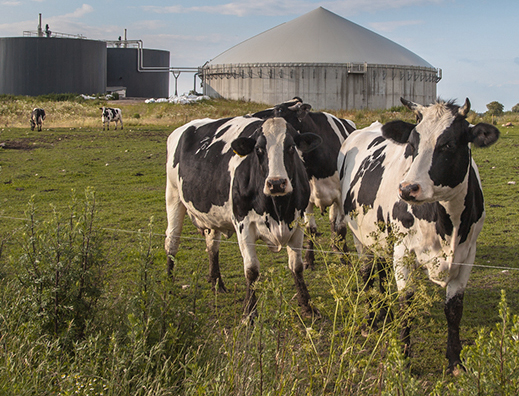Blue Flame Bounty: Turning waste to clean energy
Part 3: Renewable Natural Gas (RNG)
Natural gas: Clean, affordable, reliable and safe
As a fuel, natural gas is overflowing with possibility . . . and versatility.
It’s an abundant, low-cost, clean-burning source of energy. It’s reliable and efficient, with a well-established delivery infrastructure. And it’s an essential player in a lower-carbon future—replacing coal for electricity generation, providing low-emissions home heating, promoting growth in renewables by addressing intermittency issues.
In this third chapter of our Blue Flame Bounty series, we look at Renewable Natural Gas (RNG), a small but growing waste-to-energy stream with plenty of practical potential.

The basics of RNG
Renewable natural gas, also known as biomethane or biogas, is a natural gas produced out of organic waste—from farms, from forests, from landfills, from water treatment plants.
RNG is captured, cleaned and injected into pipelines. Once upgraded, it can be used interchangeably with natural gas by residential, commercial and industrial customers. Additionally, natural gas vehicles are capable of running on RNG—either at 100% or in blends—with no vehicle modification required.
According to the Canadian Gas Association, harnessing even 10% of Canada’s RNG potential would generate enough clean energy to heat a million Canadian homes for a year.
RNG for people on the move
In recent years, interest has been steadily growing in putting RNG to work in fleet vehicles.
In greater Los Angeles, Orange County Transit operates its bus fleet on RNG produced in landfills. In Canada, the City of Toronto and Riviere-du-Loup, QC, plan on using biogas to heat buildings, power garbage trucks, and meet other transportation needs.
Over in the private sector, Waste Management operates the world’s largest landfill gas-to-transportation fuel initiative, with RNG collected at California’s Altamont landfill powering about 300 garbage collection trucks.

![]()
In the world's conversation about energy, one point is beyond debate: Energy makes a vital contribution to people's quality of life, to society and to human progress. This is true today, and it will remain true in the future. That's why Energy Matters was created. We believe it's important to equip people with unbiased information so they may form opinions, join the conversation and feel confidence in the work and accomplishments of the energy sector. Energy Matters is an initiative that provides transparent information and perspective on energy. Here, we'll cover a range of topics: the scale of global energy; the ways energy is sourced and produced; current energy technology; forthcoming innovations; the world's future energy needs; and the sustainable sources of energy that will fill them. Because energy matters to everyone, we hope you'll rely on Energy Matters as an ongoing source of balanced information.



